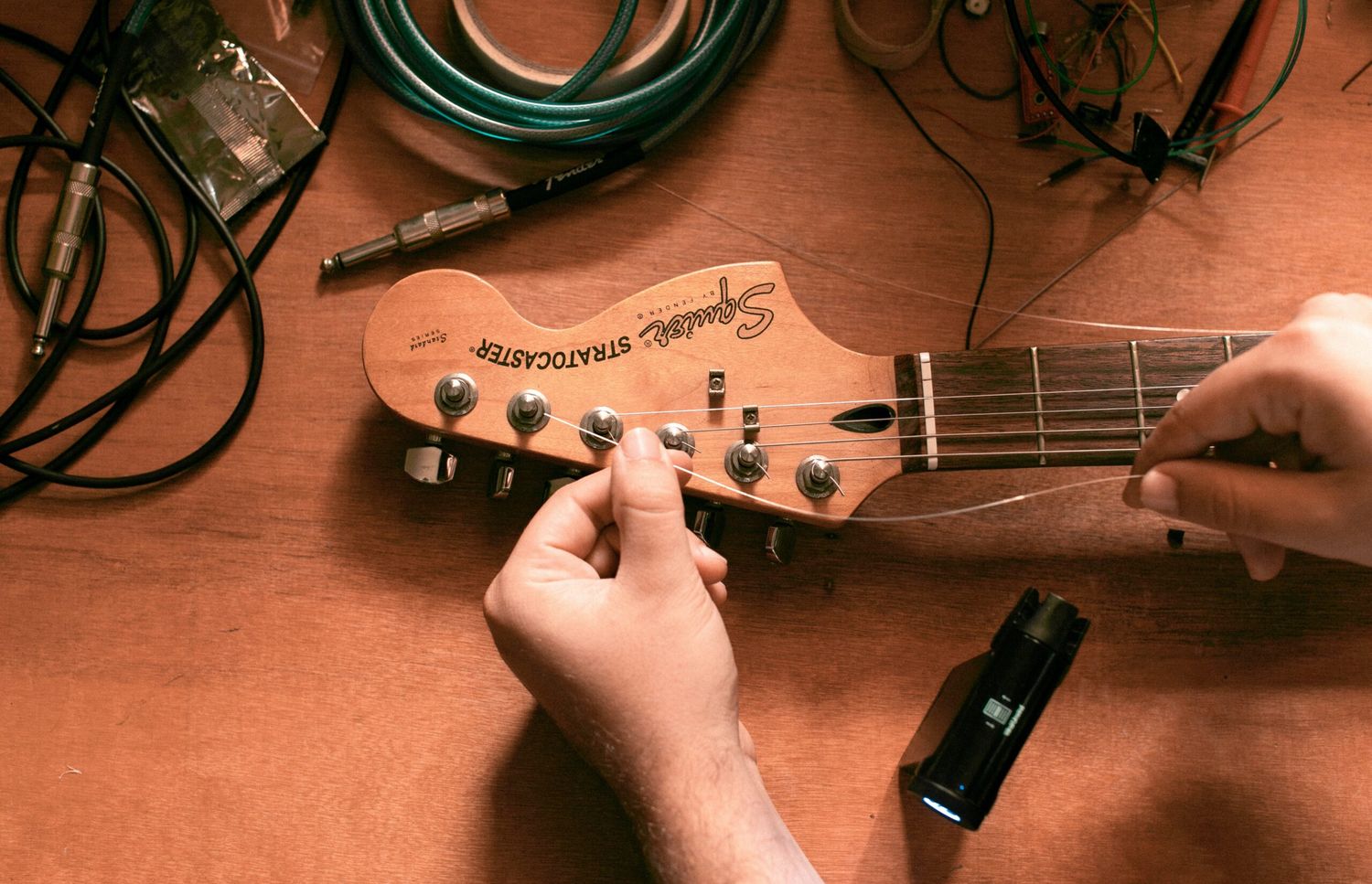Home>Instruments>Bass>How To Tune Double Bass


Bass
How To Tune Double Bass
Modified: January 28, 2024
Learn how to tune your double bass with our step-by-step guide. Improve the sound quality and achieve perfect pitch for your bass instrument.
(Many of the links in this article redirect to a specific reviewed product. Your purchase of these products through affiliate links helps to generate commission for AudioLover.com, at no extra cost. Learn more)
Table of Contents
Introduction
Welcome to the world of the double bass! This magnificent instrument, sometimes referred to as the upright bass or simply the bass, plays a vital role in the rhythm section of many genres of music. Its deep, rich tones provide a solid foundation and add a captivating depth to any musical ensemble.
Whether you are a beginner just starting your journey with the double bass or an experienced player looking to enhance your tuning skills, this article will guide you through the process of tuning your instrument. Properly tuning the double bass is essential for achieving optimal sound quality and ensuring that you are in tune with other musicians.
In this article, we will provide you with an overview of the double bass and its unique characteristics. We will then cover the steps to prepare your instrument for tuning and discuss the process of tuning the strings. Additionally, we will address common tuning problems that players encounter and provide practical solutions to overcome them. Finally, we will give you some maintenance tips to help you keep your double bass in tune for optimal performance.
So, whether you are preparing for a performance, a recording session, or simply jamming with friends, let’s dive into the world of double bass tuning and discover how to achieve the perfect pitch for your instrument.
Overview of the Double Bass
The double bass is the largest and lowest-pitched instrument in the string family. It is often used in orchestras, jazz ensembles, and various other genres of music. Also known as the upright bass or contrabass, it has a distinctive deep and resonant sound that adds richness and warmth to any musical piece.
The double bass has a unique construction that sets it apart from other string instruments. It typically consists of a hollow wooden body, a long neck, and four thick strings. The strings are usually made of steel or gut, and they are tuned in fourths—E1, A1, D, and G—starting from the lowest pitch.
Traditionally played while standing, the double bass is held upright against the player’s body. It is supported by a metal endpin, which extends from the bottom of the instrument to the ground. This allows the player to adjust the height of the bass to their preference, ensuring comfortable playing position and proper reach.
The double bass is played with a bow or by plucking the strings with the fingers, using a technique known as pizzicato. Players can produce a variety of tones and effects by adjusting the pressure and speed of the bow or the angle and force of the plucking motion.
Due to its large size and deep resonance, the double bass provides a strong foundation in any musical ensemble. It is responsible for establishing the harmony and rhythm, working in tandem with the drums and other instruments in the rhythm section. The low frequencies produced by the double bass create a solid and grounding presence, giving a sense of stability to the music.
While the double bass requires strength and technique to play, it offers a rewarding experience for musicians. Its versatility allows it to play both melodic and rhythmic roles in different musical contexts, making it a sought-after instrument for many performers.
Now that we have a better understanding of the double bass and its role in music, let’s move on to the next section: preparing the double bass for tuning.
Preparing the Double Bass for Tuning
Before beginning the tuning process, it is important to ensure that your double bass is properly set up and in good condition. Here are a few steps to follow to prepare your instrument for tuning:
- Check the condition of the strings: Examine each string for any signs of wear, fraying, or damage. If any strings are in poor condition, it is recommended to replace them before attempting to tune the instrument.
- Inspect the bridge: The bridge is a vital component of the double bass that helps support the strings and transmit vibrations to the body of the instrument. Make sure the bridge is straight, properly aligned, and securely in place. If the bridge has shifted or is leaning, carefully adjust it to its correct position.
- Check the tuning pegs: Ensure that all tuning pegs are functional and turn smoothly. If any pegs are loose or slipping, they may need to be adjusted or lubricated. This step is crucial to ensure that the strings can be tuned accurately and securely.
- Inspect the tailpiece and tailgut: The tailpiece holds the strings in place at the bottom end of the double bass. Check that the tailpiece is securely attached and that the tailgut, which connects the tailpiece to the endpin, is in good condition. If the tailgut is worn or damaged, it should be replaced to prevent any potential accidents or string breakage.
- Check the soundpost: The soundpost is a small, cylindrical wooden dowel inside the double bass that helps transmit the vibrations of the strings to the body of the instrument. It is located beneath the right side of the bridge. Ensure that the soundpost is properly positioned and not leaning or loose. If you are uncertain about the soundpost’s placement, it is best to consult a professional luthier for adjustment.
By adequately preparing your double bass before tuning, you can ensure that the instrument is in optimal condition and ready to produce accurate and stable tones. Once you have assessed and addressed any necessary adjustments or repairs, you are ready to proceed to the next step: tuning the strings.
Tuning the Strings
Tuning the strings of a double bass requires careful attention and a keen ear. Follow these steps to ensure accurate tuning:
- Start with the E1 string: Begin by tuning the first string, E1, to the desired pitch. You can use a piano, a tuning fork, a pitch pipe, or a digital tuner to reference the correct pitch. Pluck the string and adjust the tension by turning the corresponding tuning peg until the string reaches the desired pitch.
- Tune the remaining strings: Once the E1 string is in tune, use it as a reference point to tune the other strings. Press down on the E1 string at the fourth harmonic or open A1 string, creating a pitch reference. Start plucking the A1 string and adjust the tension until it matches the pitch of the E1 string. Repeat this process for the D and G strings, using the previous string as a reference for tuning.
- Check the intonation: After tuning the strings, it’s important to check the intonation. Play a few notes on each string, checking if they are in tune at different positions along the neck. Make small adjustments as needed to ensure accurate intonation across the entire range of the double bass.
- Consider the temperature and humidity: Keep in mind that temperature and humidity can affect the tuning of your double bass. Changes in environmental conditions can cause the instrument to expand or contract, leading to fluctuations in pitch. Be mindful of these factors and make slight adjustments to the tuning as necessary.
Remember that tuning a double bass is an iterative process. It may take some time and practice to achieve precise tuning, especially if you are new to the instrument. Stay patient, trust your ears, and make gradual adjustments to each string until you are satisfied with the sound.
Now that you’ve successfully tuned your double bass, let’s explore the next section, which addresses common tuning problems and provides solutions to overcome them.
Common Tuning Problems and Solutions
While tuning the double bass, you may encounter some common issues that can affect the accuracy and stability of your instrument’s tuning. Here are a few problems you might face and some solutions to help you overcome them:
- Slipping pegs: One of the most common tuning problems is when the pegs slip, causing the string tension to change. To address this, apply peg compound or peg dope to the problematic pegs. This substance provides better grip and reduces slipping. Additionally, make sure the pegs fit properly and are not too loose or too tight.
- Tuning instability: If you find that your strings are constantly going out of tune, especially during playing, it could be due to inadequate string winding on the pegs. Make sure the strings are wrapped around the pegs neatly and securely. Also, ensure that the strings are properly stretched by gently pulling on them after tuning to eliminate any excess slack.
- Inconsistent tuning across strings: If you notice that the tuning varies between the strings, it could be a sign of an improperly positioned nut. The nut is the small piece at the top of the neck that holds the strings in place. If the nut slots are too high or too low, it can affect the string height and tuning. Consulting a luthier for nut adjustment or replacement is recommended to ensure proper string positioning.
- Pitch shifting: Pitch shifting can occur when the tailpiece or tailgut are not properly adjusted or adequately secure. If you experience pitch shifting while playing certain notes or passages, it may be necessary to adjust the tailpiece or tailgut tension. Consult a professional if you are uncertain about making these adjustments yourself.
- String buzzing: Buzzing sounds can be a result of strings vibrating against the fingerboard or other parts of the instrument. This can affect the perception of pitch. Check for any buzzing or rattling noises and identify the source. It may require adjusting the string height, checking the fingerboard for levelness, or addressing any loose or worn components.
By being aware of these common tuning problems and their solutions, you can address any issues that arise and maintain stable and accurate tuning on your double bass. Regularly inspecting and maintaining your instrument will contribute to its overall playability and performance.
In the next section, we will provide you with some maintenance tips to help you keep your double bass in tune and in optimal playing condition.
Maintenance Tips for Keeping the Double Bass in Tune
Maintaining your double bass is key to ensuring that it stays in tune and performs at its best. Here are some maintenance tips to help you keep your double bass in optimal condition:
- Store the double bass properly: When not in use, it is important to store your double bass in a safe and appropriate environment. Keep it in a sturdy case or stand to protect it from potential damage. Ensure that the instrument is stored in a room with stable temperature and humidity levels to prevent any warping or damage to the wood.
- Clean the strings regularly: The strings of the double bass can accumulate rosin residue, dirt, and oils from your fingers. Wipe the strings clean with a soft cloth after each playing session to prevent buildup that can affect both tone and tuning stability.
- Check the bridge position: Regularly inspect the position of the bridge to ensure that it remains straight and properly aligned. If you notice any leaning or tilting, gently adjust it back into position. A misaligned bridge can cause issues with tuning and string height.
- Keep the double bass hydrated: Wood is sensitive to changes in humidity. To prevent the double bass from drying out or cracking, use a humidifier in the case or room where you store the instrument. This will help maintain optimal moisture levels and preserve the structural integrity of the wood.
- Regularly check and adjust string tension: Over time, the strings may lose tension and require adjustment. Make it a habit to check the tension and adjust as needed. Maintain a balance between having the proper tension for good tone and preventing excessive strain on the instrument.
- Schedule regular maintenance with a luthier: It is advisable to have your double bass inspected and serviced by a professional luthier on a regular basis. They can ensure that the instrument is in proper condition, address any issues with components or setup, and provide more advanced maintenance and repairs.
By incorporating these maintenance practices into your routine, you can help maintain the overall performance and longevity of your double bass. A well-maintained instrument will not only stay in tune but also deliver consistent and optimal sound quality for your playing enjoyment.
Now that you have learned some valuable maintenance tips, let’s conclude our journey through the world of tuning the double bass.
Conclusion
Congratulations! You have reached the end of our comprehensive guide on tuning the double bass. We hope that this article has provided you with valuable insights and practical tips to help you achieve accurate and stable tuning on your instrument.
Remember, tuning the double bass is a skill that takes time and practice to develop. Listening carefully, trusting your ears, and making incremental adjustments will go a long way in achieving the perfect pitch.
Additionally, proper maintenance is crucial for keeping your double bass in tune. Regularly inspecting and addressing any issues will help ensure optimal playability and performance.
Regardless of whether you are a beginner or an experienced player, mastering the art of tuning your double bass will greatly enhance your musical experience. The deep, resonant tones of this remarkable instrument will shine through, providing a solid foundation and captivating presence in any musical setting.
So, keep exploring, practicing, and enjoying the beautiful sound of the double bass. With dedication and patience, you will continue to grow as a musician and immerse yourself in the rich world of bass music.











